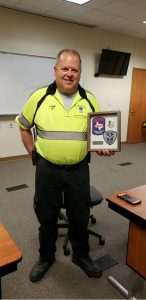In December 2020, Cooke County Emergency Medical Services (CCEMS) posted the following on social media: “Congratulations to EMT of the Year Adam Arendt. Adam has been serving the citizens of Cooke County for 11 years. Adam will be leaving CCEMS on Jan. 1 to continue his service to Cooke County as a County Commissioner. Good luck Adam!”
Arendt started with Cooke County EMS as an EMT and worked a 24/48 shift. He continued for 12 years, working on an ambulance.
“I went through extensive training and conferences over my tenure,” Arendt shared. “I enjoyed helping people and our county.”
Now in his second term as a County Commissioner, Arendt has a different role when it comes to EMS: helping ensure the crew has the resources needed to provide “the best there is.”
Surprisingly, EMS is not categorized as an “essential service” by the State of Texas. In many cases, EMS is rolled into the fire department, Arendt explained. Fire service has been categorized as essential.
“In an urban area with a large population, this would be feasible,” he elaborated. “Where the rural counties are at a disadvantage is that the bulk of the area is serviced by a volunteer fire department (VFD).”
If a VFD provides EMS, there are several potential problems, Arendt noted. The increased frequency of calls will call for more volunteers. These volunteers must hold and maintain certification by the Texas Department of State Health Services (DSHS). Both are costly and time consuming along with the added expense of operating an EMS, vehicles, equipment, supplies, etc.
As the current fire chief of the Lindsay VFD, Arendt speaks from experience.
“It is just too costly for a VFD to operate an EMS,” summarized Arendt, who has been fire chief with the VFD off and on for 28 years.
Deciding EMS was vital to the community, Cooke County elected to support a county-run service.
Cooke County provides EMS for the entire county, including incorporated areas and unincorporated areas. The county operates five stations, which are staffed 24/7. Each station has one ambulance certified by DSHS as a Mobile Intensive Care Unit.
EMS Station 1 houses one rescue truck and is staffed by a shift captain. This same station also houses an office manager, training captain, and an EMS chief who work 8 a.m.-5 p.m. Monday through Friday.
Cooke County EMS employs 36 full-time personnel and 18 part-time personnel.
The budget for this department is $4.6 million per year, Arendt reported, with revenue from EMS billing totaling approximately $2.2 million per year.
The EMS chief is responsible for budget planning and oversight, and the chief updates the Commissioners Court as needs arise, Arendt explained. The Commissioners Court approves the EMS budget.
“This is a fairly large system,” Arendt observed. “EMS can be customized to fit the population of the county.”
Cooke County is well familiar with developing a county-run system, having taken on the service in 1979 after the local funeral home decided that it was no longer feasible to continue providing it. Cooke County then grew EMS from two basic life support ambulances to its current level.
“Obviously, if a life is saved, you can’t put a value on that,” Arendt shared. “Most EMS work is not life-saving, but it is essential for the safety and security of our citizens.”
“It comes down to health and safety,” added longtime Cooke County Commissioner Gary Hollowell.
Cooke County residents do not receive bills for EMS services provided.
“We do bill the appropriate insurance, but any balance that would be a resident’s responsibility is written off,” Arendt explained.
Counties in search of EMS services often contract out for the service.
“When looking at this option, you must keep in mind these are private, for-profit companies,” Arendt advised. “If the call load increases, then reimbursement falls off or, as we have seen lately, they must increase wages to attract qualified personnel.”
In addition, the company will expect the county to increase the county’s subsidy to cover the increased cost.
“If the county is unwilling or unable to increase the subsidy, the county would have to leave,” Arendt said. “This would cause a gap in service you have to scramble to fill, and unfortunately this is a common occurrence.”
If there are issues with response time, medical care, personnel issues, etc. the county will have limited options, he added.
“The bottom line is that you cannot contract out a service cheaper than you can provide it for yourself,” Arendt maintained. “It will take some time and investment to get the key components in place. In the long run it will be more cost effective for the county, you will have better oversight, and you will provide a higher quality of care for your citizens.”















